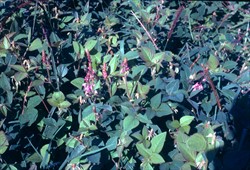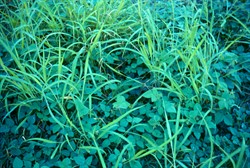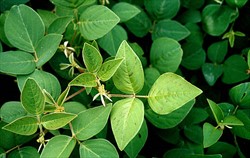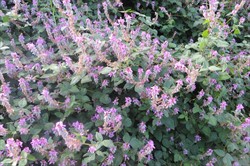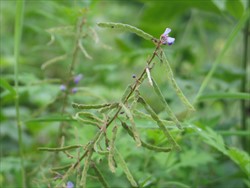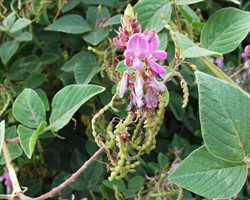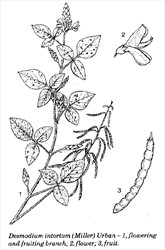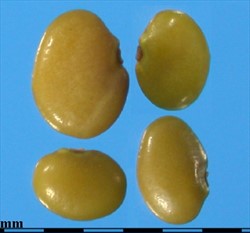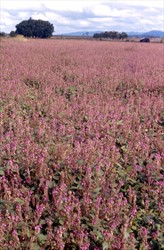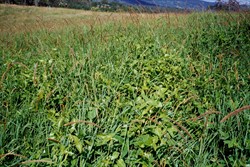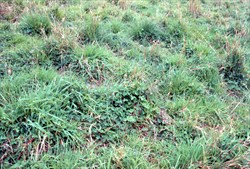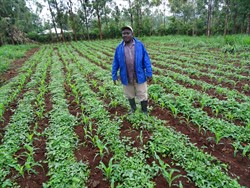Desmodium intortum
Tropical Forages
Desmodium intortum (Mill.) Urb.
Basionym: Hedysarum intortum Mill.; Desmodium hjalmarsonii (Schindl.) Standl.; Meibomia hjalmarsonii Schindl.
Family: Fabaceae (alt. Leguminosae) subfamily: Faboideae tribe: Desmodieae subtribe: Desmodiinae.
Trailing, scrambling perennial herb or subshrub with strong taproot. Stems 1.5 - 4.0 mm diameter, longitudinally grooved, often reddish-brown, sometimes ± glabrescent, mostly with dense, hooked or recurved hairs, glandular, sticky to the touch; ascendant, non-twining, rooting at the nodes if in prolonged contact with moist soil, to several metres long. Leaves pinnately trifoliolate; stipules 2 - 6 mm long, usually recurved, often persistent; petiole 3 - 5(- 9) cm long, pubescent; terminal leaflet usually ovate sometimes broadly elliptic, 5 - 13 cm long, 2 - 7 cm wide, petiolule 6 - 12 mm long; lateral leaflets 3-10 cm long, 1.5 - 6 cm wide, petiolule 2 - 4 mm; all laminae covered with ascending hairs on both surfaces; base rounded to truncate, apex acute, often with sparse reddish-brown/purplish marks on the upper surface. Racemes terminal or axillary, to 30 cm long; rachis with dense appressed to spreading hooked hairs, 2-flowered at each node; pedicel filiform, 6-10 mm; calyx 2.5-3 mm, 5-lobed, lowest lobe longest; corolla pink, purplish red to violet becoming bluish or greenish white, 9-11 mm. Pod narrowly oblong, 15-50 mm × 3-4 mm, densely covered with short, brownish hooked hairy, up to 12-articulate, lower suture deeply constricted, upper suture thickened, slightly sinuate; stipe ca. 2 mm; articles semicircular or rhombic, 3 - 6 mm, breaking up at maturity. Seeds reniform, pale brown, about 2 x 1.5 mm. 300,000 - 830,000 seeds/kg depending on provenance (595,400 seeds/kg in cv. Greenleaf).
Africa: groenblaardesmodium (Afrikaans)
Asia: 扭曲山蚂蝗 niu qu shan ma huang (China); karikuy-ritkuk, karikut-ritkut (Bagobo: name also applied to Codariocalyx spp.) (Philippines); thua kleen leap (Thailand)
English: beggarlice, giant Spanish clover, greenleaf desmodium, green-leaf tick trefoil; kuru vine (South Africa)
Europe: desmodie (French); grünes Desmodium (German)
Latin America: desmódio de folha verde (Brazil); amor seco (applied to other Desmodium spp.), cadillo, copal de coche, desmodio verde, desmodium de hoja verde, empanaditas, maricao, mozote; pega pega (generic); trébol español hojas verdes, zarza blanca (Spanish)
Native:
Northern America: Mexico
Caribbean: Hispaniola; Jamaica; Puerto Rico
Central America: Belize; Costa Rica; El Salvador; Guatemala; Honduras; Nicaragua; Panama
South America: Bolivia; Brazil; Colombia; Ecuador; Peru; Venezuela
Naturalized:
Small areas of humid higher altitude tropics and humid subtropics around the world
Forage
Used for dryland and irrigated long-term pastures, requiring careful management for longer-term persistence. It is also used for conservation as hay and silage, and for cut-and-carry systems.
Environment
Forms an effective ground cover in vulnerable areas, the abundant leaf fall and slow decomposition resulting in a deep mulch layer under the plants.
Other
Along with other Desmodium spp., D. intortum has been shown to be produce the volatile chemicals that underpin the "push-pull" control strategy for witchweed, Striga hermonthica, and cereal stemborers in crops of maize and sorghum, when grown as an intercrop.
Soil requirements
D. intortum has been collected growing on loams, sandy loams and clay loam soils, and has been successfully cultivated on a wide range of soil textures from sands and light loams to medium clays, a wider range of soils than for D. uncinatum. It prefers at least moderate fertility and appears to grow best at pH between 5.0 and 7.0. It is not tolerant of salinity or high Al and Mn, and is very responsive to Mo.
Moisture
D. intortum originates from humid areas with annual rainfall ranging from 1,000 mm to 3,500 mm. It is generally sown in areas in the lowland subtropics with annual rainfall above 1,200 mm, and in the upland tropics receiving more than 800 mm rainfall, with no apparent upper limit in either. The dry season should be less than 6 months. Tolerance to waterlogging or flooding is better than that of D. uncinatum cv. Silverleaf, which in turn is more drought tolerant than ‘Greenleaf’ due to its stronger taproot. 'Greenleaf' drops its leaf under extended dry conditions.
Temperature
D.intortum is found in a range of environments mostly in the upland tropics of Central America and northern South America (to as high as >3,000 m asl at 16° S in Bolivia), and occasionally in the lowland tropics and upland subtropics. It is a warm season plant that has found a place in cultivation in the milder climates of moderate altitudes in the tropics and low altitudes in the subtropics. It has generally not been successful in the humid lowland tropics. It starts growing later in spring than ‘Silverleaf’, but withstands hot weather better than D. uncinatum. Grows well into the cooler season although frost-susceptible. Optimum growth at 30/25 °C ±3 °C.
Light
D. intortum has good shade tolerance, and will grow under a moderate tree canopy as well as in open situations.
Reproductive development
It has a sensitive short-day control of flowering, which is restricted to mid May-early June in the southern hemisphere. However, temperature as well as daylength controls flowering in D. intortum. At similar latitudes, plants at higher altitudes flower earlier; similarly, high temperatures during the reproductive phase can inhibit flowering.
Defoliation
Mature plants are intolerant of constant heavy grazing or frequent heavy defoliation in which the growing points are removed; heavy stands are soon reduced to very small individual plants. Grazing pressure should be adjusted to retain bud sites and leaf material. Even under careful grazing management, few pastures of D. intortum persist for more than 6 years.
Fire
It does not like fire but will sprout again from the rootstock.
Guidelines for establishment and management of sown forages.
Establishment
Greenleaf desmodium has small seed resulting in slow seedling growth. It is usually established into a prepared seedbed, but it can be planted vegetatively from rooted cuttings. Oversowing seed into established pasture is not reliable because of slow seedling growth.
Machine harvested seed has a low proportion of hard seed due to mechanical abrasion during harvesting, but hand harvested seed may need scarification. Seed should be inoculated with specific rhizobia (CB 627 in Australia) prior to sowing.
Fertilizer
It requires at least moderate levels of fertility, and phosphorus, sulphur, potassium and molybdenum may need to be applied.
Compatibility (with other species)
Combines well with tussock and stoloniferous, grasses and will climb over small scrubs. Because it is adapted to cooler climates, it is often grown with subtropical grasses, e.g. Setaria.
Companion species
Grasses: Cenchrus clandestinus, Digitaria eriantha (pangola ), Setaria sphacelata. It will also combine with Megathyrsus maximus and Cenchrus purpureus.
Legumes: Macroptilium atropurpureum, Neonotonia wightii.
Pests and diseases
Stands in Australia have been severely attacked by the root-eating Amnemus weevil (Amnemus quadrituberculatus Coleoptera:
Ability to spread
It will spread into ungrazed shady areas through the rooting stolons.
Weed potential
Possible weed of riparian vegetation due to its ability to climb and its shade tolerance. It has not shown the propensity to spread beyond the sown area that has been noted with species such as Macroptilium atropurpureum and Neonotonia wightii.
Nutritive value
D. intortum leaf has high protein content but also contains condensed tannins. In vitro digestibility ranges from 52.5 to 56.6% in reasonably young regrowth, but is at least 10 units less at all stages and in all parts than siratro (Macroptilium atropurpureum). Late flowering allows it to provide carryover feed later in autumn than ‘Silverleaf’.
Palatability/acceptability
Not particularly palatable because of high tannins, but enough that it requires careful grazing management to persist. There is less need for accustomisation than with Macrotyloma axillare.
Toxicity
No toxicity recorded and no bloat.
Feedipedia link
Dry matter
DM yields of 12–19 t/ha have been recorded.
Animal production
LW gains have exceeded 500 kg/ha/yr off grass legume pastures using Megathyrsus maximus or Digitaria eriantha.
D. intortum, D. sandwicense, and D. uncinatum are part of a species complex, in which interspecific hybrids can be produced, but may be sterile. D. intortum is self-fertile with an estimated 8‒30% outcrossing. Flowers may require may require tripping by bees or other insects for pollination and good seed set. 2n = 22 (24).
'Greenleaf' flowers later than D. uncinatum cv. Silverleaf, and is thus a less reliable seed producer in areas where early frosts may occur during flowering or seed maturation. Mechanical harvest is made difficult by uneven ripening of the seed and the sticking nature of the seed pods which can ‘ball-up’. Stands are windrowed and left to dry for 2 weeks before being threshed by a pick-up harvester using the highest possible drum speed and close concave settings. While presentation yields of up to 300 kg/ha are achievable, machine-harvested yields of 80–100 kg/ha seed are more common. Bees are important for pollination.
Seedlings show good tolerance to 2, 4-D at 500g/ha and at 1600g/ha; they are sensitive to acifluorfen at 450 g/ha, but tolerant of bentazone at 1,440 g/ha, fluazifop-butyl at 210 g/ha and sethoxydim at 370 g/ha. Mature plants are reasonably tolerant of the desiccant, diquat.
- High quality feed.
- Good early and late season vigour.
- Moderately shade tolerant.
- Combines with tussock and creeping grasses.
- Low seedling vigour.
- Poor persistence under heavy grazing.
- Susceptibility to pests.
- Poor tolerance of drought and salinity.
Hacker, J.B. (1992) Desmodium intortum (Miller) Urban. In: Mannetje, L.’t and Jones, R.M. (eds) Plant Resources of South-East Asia No. 4. Forages. Pudoc Scientific Publishers, Wageningen, the Netherlands. p. 114–115. edepot.wur.nl/327785
Khan, Z.R., Hassanali, A., Overholt, W., Khamis, T.M., Hooper, A.M., Pickett, J.A., Wadhams, L.J. and Woodcock, C.M. (2002) Control of witchweed Striga hermonthica by intercropping with Desmodium spp., and the mechanism defined as allelopathic. Journal of Chemical Ecology 28:1871–1885. doi.org/10.1023/A:1020525521180
Khan, Z.R., Pickett, J.A., Wadhams, L. and Muyekho, F. (2001) Habitat management strategies for the control of cereal stemborers and striga in maize in Kenya. International Journal of Tropical Insect Science 21:375–380. doi.org/10.1017/S1742758400008481
Sweeney, F.C. and Hopkinson, J.M. (1975) Vegetative growth of nineteen tropical and sub-tropical pasture grasses and legumes in relation to temperature. Tropical Grasslands 9:209–217. bit.ly/3dC91dy
‘Greenleaf’ (derived from CPI 17916 (El Salvador), CPI 18009 (HES-4331 ex Hawaii), CPI 23189 ex Philippines) Released in Australia (1964); initially released in 1963 as cv. Beerwah.
'Kuiaha' (PI 469242) Released in Hawaii (1969); initially identified as Desmodium intortum (Mill.) Urb. but subsequently as Desmodium aparines (Link) DC.
'Tengeru' Released in Tanzania. Possibly a "re-badging" of 'Greenleaf'.
CPI 46552 Selected in Indonesia. Origin Petén Department, Guatemala (16°12' N, 500 m asl, rainfall 1,920 mm). Performed well under coconut shade, but not for heavy grazing.
